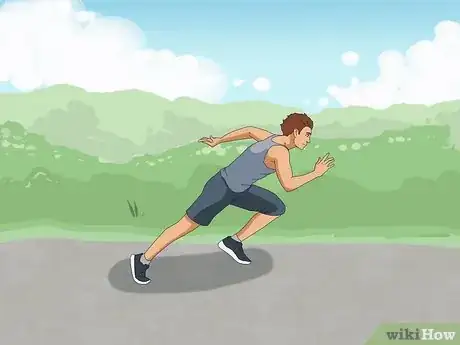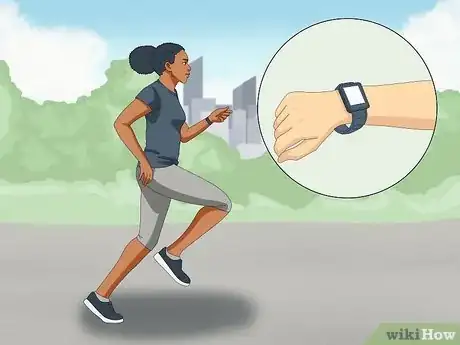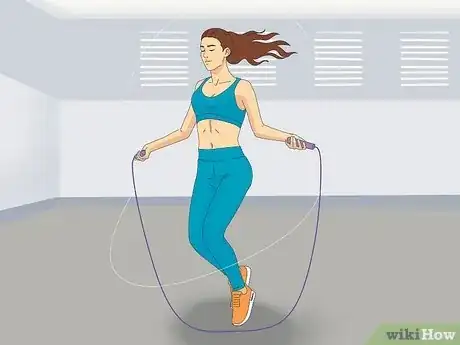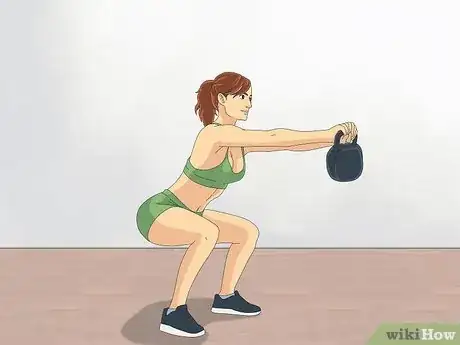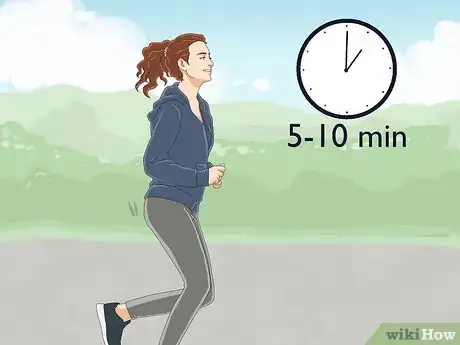This article was co-authored by Francisco Gomez and by wikiHow staff writer, Hannah Madden. Francisco Gomez is the Head Coach at the FIT Potato Gym, a training gym established in 2001 in the San Francisco Bay Area. Francisco is a former competitive runner who helps endurance athletes train for major marathons like the Boston Marathon. Francisco specializes in Injury Rehab, Flexibility, Marathon Training, and Senior Fitness. He has a B.S. in Nutrition and Exercise Physiology & Running.
There are 13 references cited in this article, which can be found at the bottom of the page.
wikiHow marks an article as reader-approved once it receives enough positive feedback. This article has 51 testimonials from our readers, earning it our reader-approved status.
This article has been viewed 4,136,331 times.
When you set out on a run, your main goal is probably to beat your personal best (or at least work your way up to it). But when simply telling yourself to “run faster” isn’t enough, how do you actually improve your stamina and increase your running distance? The good news is that we have the ability to intentionally train and continue increasing our running speed over time. And this article will walk you through everything you need to know to improve your running speed, including useful stretches, training tips, and dietary changes that will help you pick up the pace.
Things You Should Know
- Set a goal for your running time to give yourself something to work toward.
- Run sprints to increase your stamina. Or, do interval training by alternating between jogging and sprinting.
- Strengthen your core with crunches and sit-ups, and do weight training to ensure you can hold the proper running form.
- Eat a balanced diet, drink plenty of water, and give yourself rest days to keep your body in tip-top shape.
Steps
Running Tips and Tricks
Expert Q&A
Did you know you can get premium answers for this article?
Unlock premium answers by supporting wikiHow
-
QuestionWhy do I struggle to breathe when I'm running?
 Francisco GomezFrancisco Gomez is the Head Coach at the FIT Potato Gym, a training gym established in 2001 in the San Francisco Bay Area. Francisco is a former competitive runner who helps endurance athletes train for major marathons like the Boston Marathon. Francisco specializes in Injury Rehab, Flexibility, Marathon Training, and Senior Fitness. He has a B.S. in Nutrition and Exercise Physiology & Running.
Francisco GomezFrancisco Gomez is the Head Coach at the FIT Potato Gym, a training gym established in 2001 in the San Francisco Bay Area. Francisco is a former competitive runner who helps endurance athletes train for major marathons like the Boston Marathon. Francisco specializes in Injury Rehab, Flexibility, Marathon Training, and Senior Fitness. He has a B.S. in Nutrition and Exercise Physiology & Running.
Competitive Runner
-
QuestionHow quickly can I improve my running speed?
 Francisco GomezFrancisco Gomez is the Head Coach at the FIT Potato Gym, a training gym established in 2001 in the San Francisco Bay Area. Francisco is a former competitive runner who helps endurance athletes train for major marathons like the Boston Marathon. Francisco specializes in Injury Rehab, Flexibility, Marathon Training, and Senior Fitness. He has a B.S. in Nutrition and Exercise Physiology & Running.
Francisco GomezFrancisco Gomez is the Head Coach at the FIT Potato Gym, a training gym established in 2001 in the San Francisco Bay Area. Francisco is a former competitive runner who helps endurance athletes train for major marathons like the Boston Marathon. Francisco specializes in Injury Rehab, Flexibility, Marathon Training, and Senior Fitness. He has a B.S. in Nutrition and Exercise Physiology & Running.
Competitive Runner
-
QuestionWhat’s the best way for a kid to start running faster?
 wikiHow Staff EditorThis answer was written by one of our trained team of researchers who validated it for accuracy and comprehensiveness.
wikiHow Staff EditorThis answer was written by one of our trained team of researchers who validated it for accuracy and comprehensiveness.
Staff Answer wikiHow Staff EditorStaff AnswerTalk to your PE teacher or a coach about doing speed drills. They can teach you good running techniques to improve your speed and help you run without hurting yourself. Just like an adult, you should also do warmups and cooldowns before and after running to prevent injuries. Eat a healthy diet and sleep well to give yourself energy and help your body continue to grow and get stronger!
wikiHow Staff EditorStaff AnswerTalk to your PE teacher or a coach about doing speed drills. They can teach you good running techniques to improve your speed and help you run without hurting yourself. Just like an adult, you should also do warmups and cooldowns before and after running to prevent injuries. Eat a healthy diet and sleep well to give yourself energy and help your body continue to grow and get stronger!
References
- ↑ https://www.nytimes.com/guides/well/how-to-run-a-faster-marathon
- ↑ Francisco Gomez. Fitness Coach. Expert Interview. 24 October 2030.
- ↑ https://www.runnersworld.co.za/training/9-simple-steps-to-get-faster-at-sprinting/
- ↑ http://runners-resource.com/fartlek
- ↑ https://www.nytimes.com/guides/well/how-to-run-a-faster-marathon
- ↑ https://www.ncbi.nlm.nih.gov/pmc/articles/PMC5839711/
- ↑ https://www.nytimes.com/guides/well/how-to-run-a-faster-marathon
- ↑ https://www.nytimes.com/guides/well/how-to-run-a-faster-marathon
- ↑ https://pubmed.ncbi.nlm.nih.gov/24149762/
- ↑ https://www.today.com/health/diet-fitness/what-is-plyometrics-rcna41124
- ↑ https://intermountainhealthcare.org/blogs/topics/live-well/2016/05/run-faster-and-prevent-injuries/
- ↑ https://pubmed.ncbi.nlm.nih.gov/27497600/
- ↑ https://my.clevelandclinic.org/health/articles/7050-aerobic-exercise
- ↑ https://www.nhs.uk/live-well/exercise/running-and-aerobic-exercises/how-to-warm-up-before-exercising/
- ↑ https://www.hopkinsmedicine.org/health/wellness-and-prevention/runners-diet
- ↑ Francisco Gomez. Fitness Coach. Expert Interview. 24 October 2019.
- ↑ Francisco Gomez. Fitness Coach. Expert Interview. 24 October 2019.
About This Article
To run faster, try adjusting your running form, which can help improve your speed and aerodynamics. When you run, remember to lean forward and push off firmly with each foot. Pump your arms actively instead of letting them bounce with your body’s normal rhythm. Keep your elbows bent at a 90-degree angle to help propel yourself forward, and keep your spine straight with your center of gravity in front of your chest. Try to run every day since the more you run, the faster you'll get. Aim to do 4 to 5 hill sprints every time you go running. Hill sprints are one of the best ways to improve your speed. If you want to run faster over long distances, try to push yourself to run a little farther every time you go for a long-distance run. Over time, your body will adjust to the longer distances, and your time will start to improve. Keep reading to learn how to breathe properly while you run.



